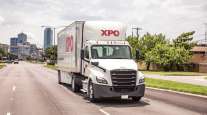LTL Fleets Boost Profits on Higher Tonnage, Price Gains
This story appears in the Aug. 6 print edition of Transport Topics.
Tonnage and pricing improvements in the second quarter helped many less-than-truckload fleets boost their profits significantly in the quarter.
The Freight division of Con-way Inc. posted its largest quarterly profit since mid-2008, Old Dominion Freight Line drove its operating ratio below 85 and the improved earnings at Saia Inc. were described by a stock analyst as “stunning.”
Carriers said they benefited from fuel prices that declined steadily during the quarter, but diesel since has started increasing again.
Higher profitability was not universal, though, as the loss at Vitran Corp. accelerated.
“Solid LTL reports so far in the second quarter,” Wolfe, Trahan & Co. wrote to its clients on July 30. Several LTL carriers benefited from a “balance of modest tonnage growth and strong yields,” the report said.
Old Dominion CEO David Congdon said in an Aug. 2 statement that his carrier set quarterly records for its revenue, margins and earnings per diluted share.
Quarterly operating ratio — expenses as a percentage of revenue — improved to 84.7 from 86.5 in last year’s second quarter. Congdon said the OR result is the company’s best ever in its 78-year history.
ODFL’s basic revenue per hundredweight, or pricing before fuel surcharge, rose by 4.1%, year-over-year, he said, even though weight per shipment increased and length of haul decreased.
Overall, the company earned $47.8 million, or 83 cents a share, on revenue of $541.5 million. In the year-ago quarter, it posted a profit of $39.4 million, or 69 cents a share, on revenue of $480.3 million.
Con-way Freight’s operating income was $53.4 million on revenue of $878.5 million. In the same period a year ago, the LTL division had a profit of $39.2 million on revenue of $839.8 million.
The July 31 report from Con-way said the LTL unit benefited from “continued price improvement, operating efficiency and cost control.”
The previous time Con-way Freight earned more was when it topped $61 million in the third quarter of 2008. Operating ratio improved to 93.9 from 95.3 in the year-ago period, but part of that came from a property sale, diminishing the luster of the profit, for at least one analyst.
“Con-way Freight reported worse-than-expected volume growth — 0.9% tonnage growth, year-over-year, versus our 1.5% estimate — and revenue per hundredweight expansion rose 3.2% versus our 4.5% estimate,” David Ross wrote to clients of Stifel, Nicolaus & Co.
Parent company Con-way Inc. earned $41.8 million, or 74 cents a share, on revenue of $1.45 billion. In last year’s quarter, the company made $29.4 million, or 52 cents a share, on revenue of $1.35 billion. Con-way also has truckload and logistics divisions.
At Saia Inc., net income more than tripled to $11.9 million, or 72 cents a share, from $3.4 million, or 21 cents a share, even though revenue rose only 8.1% to $287.5 million.
Thom Albrecht of BB&T Capital Markets called the turn-around “stunning.” He said more fuel-efficient trucks are leading to decreased spending on diesel and maintenance, Saia’s sales force has improved, relationships with third-party logistics providers are better, and basic operations such as trailer loading and pickup and delivery have improved.
“A slow-growth environment is good for them as the need to add back-office is minimal; labor overtime, equipment rentals and part-time expenses are minimized,” Albrecht added.
Roadrunner Transportation Systems reported net income of $10.2 million, or 32 cents a share, up from $7.4 million, or 24 cents a share. Revenue grew to $262.5 million from $208.3 million.
Quarterly LTL operating ratio improved to 91.9 from 93.7, CEO Mark DiBlasi said.
The company’s tonnage hauled grew by 3.3%, the number of shipments rose 5.2% and basic freight pricing grew by 4.4%.
Arkansas Best Corp. posted a doubling in net income, but much of that was driven by a one-time tax accounting benefit. Profit was $11.8 million or 44 cents a share, up from $5.3 million, or 20 cents a share, a year earlier. Revenue expanded to $510.5 million from $498.6 million.
At flagship LTL carrier ABF Freight System, operating income rose to $7.7 million from $7.6 million.
On a sequential basis ABF returned to profitability after a first-quarter loss. ABF quarterly revenue dipped to $445.7 million from $452.1 million, and quarterly OR remained at 98.3.
The CEO of a privately held LTL said his business is doing better, somewhat because of tonnage improvement but largely because of less competition since the recession years of 2008-09. He spoke on the condition of anonymity.
Vitran Corp. said July 19 it lost $4.16 million, or 25 cents a share, on revenue of $213.1 million. In last year’s second quarter it lost $2.3 million, or 14 cents a share, on revenue of $208.9 million.
Vitran, Toronto, said the losses came from the company’s U.S. LTL operations but that management was “pleased” with Canadian LTL and logistics results. Quarterly OR for the LTL unit deteriorated to 101.8 from 100.7.
YRC Worldwide was scheduled to report Aug. 3, too late to appear in this issue.
The LTL divisions of the two largest parcel carriers also reported improvements in profits, with UPS Inc. in July (7-30, p. 5) and FedEx Corp. in June (6-25, p. 2).




